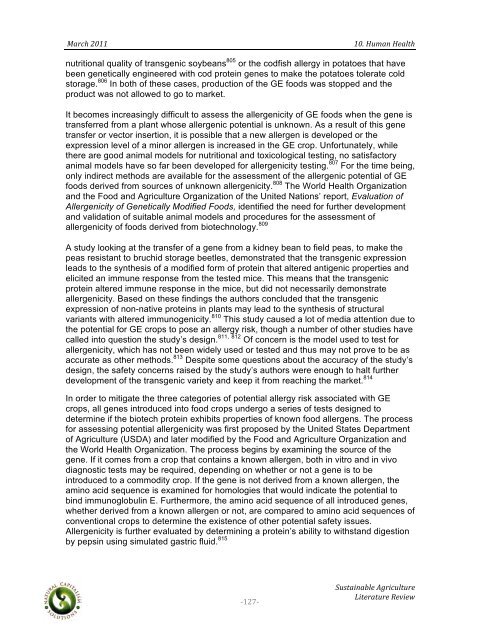Sustainable Agriculture Literature Review - Boulder County
Sustainable Agriculture Literature Review - Boulder County
Sustainable Agriculture Literature Review - Boulder County
You also want an ePaper? Increase the reach of your titles
YUMPU automatically turns print PDFs into web optimized ePapers that Google loves.
! !!<br />
"#$%&!'())!! !!!!!!!!!!!!!!!!!!!!!!!!!!!!!!!!!!!!!!!!!!!!!!!!!!!!!!!!!!!!!!!)(+!03B#5!01#/2&!<br />
nutritional quality of transgenic soybeans 805 or the codfish allergy in potatoes that have<br />
been genetically engineered with cod protein genes to make the potatoes tolerate cold<br />
storage. 806 In both of these cases, production of the GE foods was stopped and the<br />
product was not allowed to go to market.<br />
It becomes increasingly difficult to assess the allergenicity of GE foods when the gene is<br />
transferred from a plant whose allergenic potential is unknown. As a result of this gene<br />
transfer or vector insertion, it is possible that a new allergen is developed or the<br />
expression level of a minor allergen is increased in the GE crop. Unfortunately, while<br />
there are good animal models for nutritional and toxicological testing, no satisfactory<br />
animal models have so far been developed for allergenicity testing. 807 For the time being,<br />
only indirect methods are available for the assessment of the allergenic potential of GE<br />
foods derived from sources of unknown allergenicity. 808 The World Health Organization<br />
and the Food and <strong>Agriculture</strong> Organization of the United Nations’ report, Evaluation of<br />
Allergenicity of Genetically Modified Foods, identified the need for further development<br />
and validation of suitable animal models and procedures for the assessment of<br />
allergenicity of foods derived from biotechnology. 809<br />
!<br />
A study looking at the transfer of a gene from a kidney bean to field peas, to make the<br />
peas resistant to bruchid storage beetles, demonstrated that the transgenic expression<br />
leads to the synthesis of a modified form of protein that altered antigenic properties and<br />
elicited an immune response from the tested mice. This means that the transgenic<br />
protein altered immune response in the mice, but did not necessarily demonstrate<br />
allergenicity. Based on these findings the authors concluded that the transgenic<br />
expression of non-native proteins in plants may lead to the synthesis of structural<br />
variants with altered immunogenicity. 810 This study caused a lot of media attention due to<br />
the potential for GE crops to pose an allergy risk, though a number of other studies have<br />
called into question the study’s design. 811, 812 Of concern is the model used to test for<br />
allergenicity, which has not been widely used or tested and thus may not prove to be as<br />
accurate as other methods. 813 Despite some questions about the accuracy of the study’s<br />
design, the safety concerns raised by the study’s authors were enough to halt further<br />
development of the transgenic variety and keep it from reaching the market. 814<br />
In order to mitigate the three categories of potential allergy risk associated with GE<br />
crops, all genes introduced into food crops undergo a series of tests designed to<br />
determine if the biotech protein exhibits properties of known food allergens. The process<br />
for assessing potential allergenicity was first proposed by the United States Department<br />
of <strong>Agriculture</strong> (USDA) and later modified by the Food and <strong>Agriculture</strong> Organization and<br />
the World Health Organization. The process begins by examining the source of the<br />
gene. If it comes from a crop that contains a known allergen, both in vitro and in vivo<br />
diagnostic tests may be required, depending on whether or not a gene is to be<br />
introduced to a commodity crop. If the gene is not derived from a known allergen, the<br />
amino acid sequence is examined for homologies that would indicate the potential to<br />
bind immunoglobulin E. Furthermore, the amino acid sequence of all introduced genes,<br />
whether derived from a known allergen or not, are compared to amino acid sequences of<br />
conventional crops to determine the existence of other potential safety issues.<br />
Allergenicity is further evaluated by determining a protein’s ability to withstand digestion<br />
by pepsin using simulated gastric fluid. 815<br />
!<br />
"'(+"<br />
!,342#.5#6/1!78$.%3/23$1!<br />
9.21$#23$1!:1;.1
















